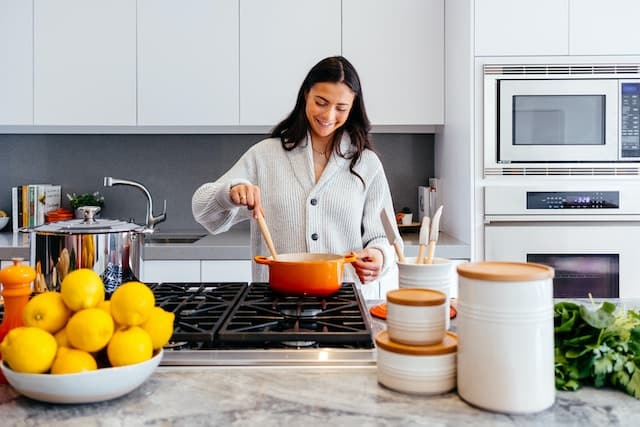What are the most effective setups for a kitchen recycling and waste sorting area?

A kitchen is not just a place for cooking and eating. It is a space where waste is constantly generated, be it food scraps, packaging, or old kitchen tools. Being conscious of this, it is essential to find ways to manage and sort this waste to minimize its impact on the environment. In this article, we will explore some of the best setups for a kitchen recycling and waste sorting area, taking into consideration factors such as design, space, and functionality.
High-Quality Kitchen Bins Designed for Recycling
Investing in high-quality kitchen bins that are specifically designed for recycling can make a significant difference to your waste management system. Gone are the days where all waste is dumped into one trash bin. Modern kitchen bins now come with multiple compartments for different categories of waste, such as general waste, plastics, glass, and food waste. This not only allows for easy waste sorting but also helps to keep your kitchen clean and odor-free.
En parallèle : What are the top considerations for integrating a built-in espresso machine in a small UK kitchen?
Having a dedicated bin for food waste can also encourage composting, transforming organic waste into nutrient-rich compost for your plants. The design of these bins is usually slim and sleek, allowing them to fit into narrow spaces in your kitchen. There are also options for pull-out bins that can be hidden away in a cabinet, providing a neat and clutter-free look.
An example of such a bin can be found on Houzz, the popular home design and remodeling platform. The 'Simplehuman 58 Liter Dual Compartment Recycling Bin' is a popular choice among users, with its sturdy stainless steel design and separate compartments for recyclables and general waste.
Avez-vous vu cela : Deliciously easy and quick recipes for busy lives
Utilizing Kitchen Cabinets as Waste and Recycling Storage
Kitchen cabinets can be a great solution for waste and recycling storage. Some homeowners may prefer to keep their waste bins out of sight, and this is where cabinets come in handy. You can install pull-out drawers or bins inside your cabinets for easy access and maintain a clean look in your kitchen.
Having a dedicated cabinet for waste disposal can also provide ample space for sorting different types of waste. You can use different containers for paper, plastics, glass, and metals, and label each container for easier identification.
This setup is also ideal for those who have limited floor space in the kitchen. By utilizing the vertical space inside your cabinets, you can still have a functional recycling and waste sorting area without cramping your kitchen space.
Incorporating Waste Sorting into Kitchen Design: The role of Vanities, Rugs, and Tiles
When planning your kitchen design, consider incorporating waste sorting into the setup. This could mean having designated spots for your waste bins in your kitchen layout, or even integrating waste sorting as part of your kitchen furniture.
For instance, a kitchen island or vanity can be designed with built-in compartments for waste bins. This creates a central hub for waste management, making it easier for you to sort and dispose of waste while you cook or clean.
Additionally, you can use visual cues in your kitchen design to promote waste sorting. For example, use different color tiles or rugs to indicate the different areas for waste disposal. This can be especially helpful for households with children, as it can teach them about waste management in a fun and engaging way.
Choosing the Right Furniture: Tables and Chairs
The right furniture can also contribute to a successful kitchen recycling and waste sorting area. Tables and chairs with built-in storage can provide additional space for waste bins or recycling bags.
A good example is a dining table with shelves underneath, where you can place small bins for waste sorting. Not only does this save space, but it also encourages recycling and waste sorting during mealtimes.
On the other hand, kitchen chairs can also serve a dual purpose. Consider chairs with hollow bases where you can stash small waste bins, or chairs with built-in hooks on the back to hang recycling bags. This can be particularly useful in small kitchens where floor space is at a premium.
Adopting the Best Practices for Kitchen Waste Management
Now that we've explored the different setups for a kitchen recycling and waste sorting area, it's important to remember that the success of these setups will largely depend on your commitment to waste management.
Adopting good waste management habits, such as rinsing out containers before recycling them or composting food waste, can greatly enhance the effectiveness of your recycling and waste sorting area. Practise mindful consumption by reducing the amount of waste you produce, and engage in regular recycling habits.
Remember, it's not just about having the best design or the most innovative storage solutions. It's about creating a system that works for you and your household, and most importantly, one that encourages responsible waste management and contributes to a more sustainable world.
Streamlining Kitchen Design for Waste Management: Involving General Contractors
When considering a kitchen renovation or a new build, incorporating waste management into the overall design can lead to more efficient use of space and promote recycling habits. Involve general contractors in your plans to create a custom website for your project management. This can serve as a central platform to communicate your recycling goals and design ideas.
For example, strategically place recycling bins near the area where you'll be preparing food. This makes it easier to sort waste as you go along, reducing the time and effort it takes to sort waste after cooking. Also, consider placing a bin or compost bucket under the sink for easy disposal of food waste.
Talk to your contractor about incorporating built-in recycling centers into your kitchen design. These can be seamlessly integrated into your cabinets or under your kitchen island, keeping them hidden but accessible.
Using outdoor lighting in your kitchen can also promote waste sorting and recycling. For example, install lighting wall fixtures above your waste and recycling area to make it easier to sort waste, especially during the evening hours.
Involving your contractors in your waste management goals can lead to a more efficient kitchen design that promotes recycling and reduces waste.
Efficacy of Technology in Kitchen Waste Management: Invoicing Billing to Lead Generation
Technology can be a powerful tool in managing kitchen waste. In addition to using tech-savvy recycling bins and composting devices, consider embracing digital solutions for waste management.
Start by leveraging invoicing billing software to track your waste production. By monitoring how much waste you're generating, you can identify areas where you can reduce waste and improve your recycling efforts.
Next, consider using lead generation tools to find local recycling programs and services. These tools can connect you to local recycling centers, bulk food stores, and composting programs that can help you manage your waste more effectively.
Lastly, create a custom website dedicated to your kitchen's waste management. This can serve as a platform to educate your family and guests about your recycling system, provide updates on your waste reduction progress, and share tips on waste management.
Technology can significantly enhance your kitchen's waste management system. From invoicing billing to lead generation, adopting digital solutions can streamline your recycling efforts and help you reduce waste.
In Conclusion: The Kitchen, a Hub for Waste Recycling
Creating an effective kitchen recycling and waste sorting area involves careful planning and consideration. From the type of bins used to the kitchen design and the involvement of general contractors, every detail plays a role in creating a system that not only looks good but functions effectively.
The use of custom furniture, from tables and chairs to bathroom vanities, can all contribute to an efficient waste management system. Even the use of lighting, both indoor and outdoor, can help in creating a space that encourages and facilitates waste sorting and recycling.
Beyond the physical setup, adopting good waste management habits is key. From rinsing containers before disposal to regular composting of food waste, these habits can greatly enhance the effectiveness of a kitchen waste management system.
Overall, remember it's not just about the design or the aesthetic appeal. It's about creating a system that promotes responsible waste management and contributes to a more sustainable world. The kitchen, after all, is not just a place for cooking and eating. It can also be a hub for waste recycling. With careful planning and commitment, your kitchen can play a significant role in reducing waste and promoting a sustainable lifestyle.
